Woodcuts and Some Words
THERE be some who tell us that to wood-engrave is to attempt "a more difficult way of doing something that could be done easily," and that "pen-and-ink drawing will achieve all that our forefathers aimed at in the woodcut." This is seen to be an error as soon as you look at a pen-and-ink drawing of today; for it neither achieves what our forefathers achieved when they drew with a pen, nor at all what they achieved in wood-engraving. The pen drawings and wood-engravings in the New York, London, and Milano collections are at our service to prove this.
It is not actually very difficult to engrave on wood. Were it difficult, it would be a poor process and it would never have become as popular as it became and remained for many hundred years. For it was the most popular process once upon a time, and thousands of men engraved on wood, some badly, some well - some very well. Their engravings, even those plain line blocks such as the designs to Aesop's Fables printed in 1480, in Milano, the Valturius of Verona, 1472, the Biblia Latina of Venezia, 1499, or the Joseph Crawhall engravings of 1880, are utterly unlike pen drawings. They are so to me, at least.
Those who say that wood-engraving is a long way round for arriving at what a pen can do, mean commercial matters. They mean that when Mr. John Swain reproduced by wood engraving John Leach's famous 'Peasantry on their way to an Irish Fair,' poor Swain had to sweat twice as much as Mr. Henschel or Mr. Swan, who later came to make photographic reproductions of the work of Mr. Pennell and his later school of penmanship. And even this has yet to be proved.
They also mean (and here they are quite correct) that to use wood-engraving to interpret a wash drawing is to take the difficult way instead of the easy way. Judging from the examples we possess of this sort of work, it would seem that it is also the wrong way. It really does not matter which is easy and which difficult. For suppose a way to be the more difficult way and yet the most successful, the mere difficulty will not overwhelm us. It is only when we take immense difficulty to achieve failure, even though we be successful commercially, that we say the method is bad, the road the wrong one.
This engraving of tints so smooth that one could hardly see the cuts of the graver is what they achieved in the nineteenth century. The finest of such work was called 'delicate' work. The broader came to be considered the work which an amateur could, without much trouble, teach himself. 'Delicate' work seemed to be the holy of holies; broad work was considered as nothing. It was not the public who decided this for us, it was the craftsmen; those craftsmen who had to copy on wood some design by Benjamin West, by John Martin, or by Hogarth and a hundred other painters. This is a thing no one should have ever been given to do, there being better ways of reproducing such pictures, but not cheaper ways; and there comes the trouble. It was, as I have said, for commercial reasons that wood-engraving reached to such popularity as it did in the nineteenth century.
The world had to have a picture of 'Prince Albert landing at Dover Pier.' It had to be about a foot and a quarter by a foot large, and it had to look as photographic as possible: real sky, real waves, real wood of the pier, real sea-gulls and clouds, real rain, mist, or whatever there happened to be on that day.
Nothing at all like this was ever attempted in the old days when they wished to record any event, such as the entry of Louis XI into Rheims in 1462. But if you start by letting the wrong man say what is wanted, and then let him put on men to do the wrong job in order to bring us a thing we neither want nor need, not only a whole craft and a whole art can be wrecked, but a whole world too.
It's distinctly jolly for the wrong man at the beginning, but it's hard luck on the right men at the end. It might have been cheaper to reverse the matter, to have made such laws that would have prevented a great donkey from controlling such a power as wood-engraving became when allied with the Press if he was so utterly unable to control it.
This is one of the things artists talk about in their studios from century to century. They have a wee bit of wit which belongs to their race, and which is other than other people's wisdom. I am tired of seeing Shelley's assertion that 'Poets are the unacknowledged legislators of the world.' God forbid that poets and other artists should be allowed to muddle such a thing as legislation. But they do voice the opinion of the ordinary man of common sense when they say that you should not employ the wrong man to set tasks for the whole world. This is such an everyday bit of common sense, this and like notions which the man in the street and the artist have in common; and the very eccentric dreamers, though much greater men in Empire Government, should try to acquire it.
It is not surprising that everybody is now and again grieved to see this one point utterly disregarded by mighty Prime Ministers and almost as mighty a Press.
And so for some sixty or seventy years - I don't know exactly how long - we had preposterous wood-engraving, and now we have a ruined craft and young men are rebuilding it.
It was not so as to interpret nonsense that fine artists such as Altdorfer, Bewick, Blake, Calvert, William Harvey, Millet and W. H. Brooks, Crawhall and Vallotton once engraved; and Nicholson and Charles Ricketts, who have both engraved marvellous things; and Sturge Moore (to me ever delightful and successful), Shannon, Savage (a born wood-engraver), Pissaro (another), Paul and John Nash, Strang and Gibbings, Lee, Sleigh, Brangwyn, Wadsworth, Gill, Mrs. Raverat, Mrs. Garnett and some hundred others, still engrave. They do it because they like the medium for their own ideas, and some have handled it, or can handle it, brilliantly; others, if less brilliantly, very admirably.
We must abide by what these men hold about wood-cutting. You don't suppose that Nicholson is going to sit down and engrave a large block of Turner's 'Ulysses defying Polyphemus.' I believe he could do it, but I fancy he has not yet done it; nor is it likely that he would even sit down and engrave a block interpreting one of his own still-life paintings. For wood-engraving was not made for the purpose of copying other works of art. Wood-engraving is a medium for creating a new work of art, a little one or a big one.
There have been, however, a few interpreters who were fortunate in possessing the talent of the born translator. For example, do you know the works of the engravers Paillard, Dete, Tinayre, Noel, and Bellenger (circa 1890)? These interpreted the work of other men, and I doubt whether any machine could interpret as they did. For they did not copy, they interpreted faithfully, speaking in a way in which only the graver and scooper can speak, not mechanically - faithfully, yet freely, from one language to another.
Do you know their illustrations to Le Theatre, by Sarcy (1893)? I have it before me: The lovely use of white touches on black in the trifle on page 50, which shows us 'La Colonne Morris ' - most excellent M. Paillard! The tail-piece on page 59 by M. Dete - it is out of the question that a pen could do what is done there. Let anyone try, put it to the test.
It is not difficult to detect the pen line from the woodcut line. A pen line, more often than not, has a certain loose drag or flick about it. A similar line in the wood-cut is far more deliberate and is cleaner. When there are a quantity of lines together, you will see that those of the pen lack all the deliberation of the engraved line.
Vierge, who is held to be the greatest pen draughtsman we have had, made drawings with the pen, with immense and unnecessary pains, to be engraved line for line. Some of these engravings are merely mechanical copies and are, of course, 'a more difficult way of doing' what a photographic process can do so very easily. It is always a mere copy unless the engraver adds something of his own to the design, something worth having, and which nothing else but one of the tools can give. This is done by M. Allouis in his engraving of one of Vierge's drawings for 'L'homme qui rit' (English version, 1889, vol. ii. page 61). I hold that Paillard and Dete did this, too, and also he who cut the little blocks used to illustrate the History of Napoleon, by R. H. Home (1841). On pages 34, 55, 101, 129 of this history, and the smaller of the two designs on page 109, volume i., I find blocks which are very good - but the name of the engraver has faded - I can hardly trace it - is it H. Lavoignat?
Raffet was the designer. When a nobody engraved one of Raffet's designs, it lost almost everything; when M. Lavoignat engraved them, something specially beautiful is added to them.
The nineteenth century, having laid down the law that any broad work on wood was beneath contempt, that it was a thing that 'an amateur could, without much trouble, teach himself,' it followed that so as to avoid being thought to be an amateur, broad wood engraving was shunned.
But since broad wood-engraving is, in truth, the best part of genuine wood-engraving, it came about that wood-engraving died out, and today is so little known that people believe that it would need some extra magic to bring it to life again.
I have no doubt that our wood-engraving of to-day is looked on by some fine old disciple of the school 1840-50 as very laughable and ridiculous; just as we see today that the brilliant scenic work of the young men is looked on with silent disdain by the disciples of the utterly bad scene painting of the past. Only bad in this: that they attempted to do what should never be attempted. Their offence is that they offend common sense.
So when anybody tells you it is difficult to wood-engrave, do not entirely believe them. It may not be as easy as strolling down a country lane, but it is not half as difficult as, for example, typewriting and stenography.
But it is quite other than these, and it is of no use for you to learn to master the very few difficulties of wood-engraving, if you have nothing to say when you have mastered them. But that does not render it any more difficult than any other craft; for in singing (and singing is a craft, not an art) suppose yourself gifted with a divine voice, and suppose after three years at Milano or Paris, you came to master all the difficulties of voice production, even then it is of no use to you, and it is of no use to nine-tenths of those who own such voices and who master the rules, if you have nothing to express. And so, the main difficulty in wood-engraving is to know if you have anything to express, and to find out how long you can retain your original intention of expression.
I have said that American and Turkey box trees yield the largest slices of wood, but that English boxwood, though much smaller, is the best. The Turkey boxwood is rather full of cracks, because when they cut down the trees, they do it so carelessly, that as the trees give up the ghost and strike the ground, a shudder runs through them, and cracks the wood from top to bottom. The smaller English trees are more easily cut down, and are handled with greater care.
The English boxwood is also harder, firmer, and does not crumble as you cut it. Crumbling means that when you cut a line with the graver on a poor piece of boxwood, it breaks along the edge as though you were cutting on a block of salt, does not cut slickly as though you were cutting butter. A good piece of boxwood should cut like butter. It is sufficiently moist, even when quite dry; when over-dry, it will begin to crumble.
In order not to let them get too dry you must not keep your blocks too long shut away from the air, although you must not keep them in any place that is at all damp. Should your wood become over-dry, there are two ways to bring it to itself again. They are as follow: Put the block into a deep earthenware pot like the Italian oil jars, in which for some unknown reason people plant orange trees. Place this in a very cool corner for about ten hours. If the wood is too dry for this to have any result, place the block in water, on its back, in a shallow dish, the water to surround the block one sixteenth of an inch deep. Leave it there for an hour or rather less.
In selecting your boxwood, remember that the best pieces are of the same tone all over, and that tone a good yellow. This good yellow boxwood will withstand the effects of the spirits of turpentine which, later on, you must use to clean away the ink, whereas the boxwood from Turkey and America will drink up the turpentine and this, in time, will have a bad effect on the block. They say that the wood of apple, pear, and beech trees have been used for engraving, but I would advise you to keep to the boxwood, for the one great advantage that it possesses is that the worm cannot eat it. You had better not eat it either, for it is somewhat poisonous. People who have seen chips lying about while they were working, and nibbled at them, have become ill. A rabbit, once playing . . . but enough.
So much for the block itself.
Now for the drawing on it. I have already told you that I only sketch very roughly the thing I am going to engrave, and then make variations in the design as I cut, following no hard-and-fast outline, or anything else. I merely catch at opportunities as I go along. But other people do very differently.
The surface of a block is generally as polished as ivory, and so it should be; but some men, when they come to draw on the block, remove this polish in the following manner. With a little powdered bath brick and a very little water mixed, they rub the smooth surface of the block. When this is dry, they rub it away with the palm of the hand, removing all the powder that may be there, so that their pencilled lines may not suffer by encountering specks of grit. All you are wanting to do is to make the surface of the block more easily drawn on. Other artists will use another method of preparing the surface, which is to mix flake white and gum water and lay it thinly on the block and let it dry. When dry it becomes dead white. Be careful not to put too much flake white in the mixture. I myself cannot use either of these two processes because it seems to me that I destroy some of the nature of the block. And, strange as it may seem, it is the nature of the block which urges me on and helps me. Were I to turn it into what looks like a piece of white paper, I should quite lose my head. As it is more than likely that you feel like this too, I can assure you that you needn't fear that something is going wrong.
What you might do is to rub the rather too smooth surface of the block with a clean but well-worn piece of india-rubber. Rub as hard as you like, as though rubbing out a drawing. This takes off some of the superfluous shine.
In drawing on the plain block without any preparation on it, you cannot do better than to use the pencil which is known as the Leighton pencil made by Wolff and Son. It is not too soft, and it is not too hard, and, I regret, not too cheap. I have found that a B or a BB is better than an HB for the block; because, when you draw on the block you must not scratch or press too hard, for that makes a dent in the wood and this can affect the print later on. You had best be careful not to smudge the drawing with your hands, as you pass them over and around the block while cutting; and if you breathe too heavily on your block while cutting, it will make your pencil lines more liable to smudge. But common sense will guide you in these matters, and it is unnecessary to terrify you with a lot more warnings, as to what you should not do.
Having drawn on your block, you now engrave it - with what? May I suggest with as few tools as possible. There are several kinds of tools. These are called gravers, gouges, chisels, tint, and, I think, something called a sculptor. What I believe you will need is a graver and a gouge to begin with. Don't get any more. If you do, you won't know what to do with them. Whereas if you don't, you'll soon know what you want. I can't say what you will want, but for your first gouge and your first graver get a medium-sized gouge and a small graver. I don't know if Mr. Buck in Tottenham Court Road still keeps these engraving tools, but it was at his house that I found most of mine, and two of my best. They supply handles for these which add to their length - what this length should be depends on the size of your hand. I have a good-sized hand. It measures exactly eight inches from the first line around the wrist to the tip of the middle finger, and is four inches wide. The tool I like best to hold measures exactly five inches. When I am holding it in position, one-half inch extends beyond my first finger, which I use for the top of the tool and to keep it steady. My thumb and second finger serve as steadiers on each side of it. This does not mean to say that you grip the tool with all three fingers as in the clutch of a drowning man. The fingers just hang around there attentively and help things along, the main thing being to keep the point of the tool steady. The handle rests in the palm of the hand but I shall never be able to explain by words exactly where it does rest, so I give you a plan of my hand. The spot marked by a small circle is the place where the handle rests. That is the spot which presses the handle and moves it. It is not by strength of fingers that you move it; it is by the weight of the arm. The fingers only guide.

And the small circle is the medal I have already told you of.
Anyone with smaller hands will, I suppose, use rather smaller tools. Don't be troubled about not being able to get each tool exactly the same size, for it does not matter, but bear in mind that it is best that they should not protrude more than half an inch beyond the reach of your finger when in the position of cutting.
And get some wood engraver to show you this way of holding the tool.
Now you have the block and the tools, and you've drawn on your block. Is there anything else you want before you begin to cut?
I believe it is usual to have what is called a sand bag on which to rest your block; and a globe with water in it; but I have never been able to bring myself to get these things. I used to find, however, that it was good to rest my block on something besides the table, and so I used a book. But a book without a cover, or a nice old eighteenth-century leather-covered one, something with a little give to it. Or I would bundle up a handkerchief beneath the block. At any rate, I would generally begin cutting in this way with something to keep the block from slipping; but as things grew fast and furious? everything would be pushed aside so that I could keep the block easily turning. For turning it helps you when you wish to curve your line a little. You turn the point of your tool - but you turn the block too - at least I do.
The light should come from the window at your left, or, if you work at night, from a lamp in front of you, with a shade throwing the light down on the block. You can't work unless the light is thrown down on the block.
And I think you're now ready to begin.
I will suppose you to make some design on the wood, and not that you will commence with fifty straight lines as an exercise. You make some design, then; and whatever is black on the design is to be left untouched; whatever is white is to be cut away. The chief thing you have to do is to hold your block tight with your left hand so that as you cut - and the cutting is a stiff process - you do not slip and send the tool, with the full force of your right arm, into one of the fingers of the other hand. For, if you do this, it is possible that you may take a great dislike to wood engraving. This is quite one of the most difficult things to avoid doing, and you won't avoid it for a long time. So - keep the fingers of your left hand out of the way. Whatever direction you see the point of the graver or gouge going in, keep the fingers out of the way. Then try and cut the 'ditch'(that is, the white space) so as to leave the line or black space just the shape you wish it to be.
Suppose you draw the letter X and the figure 8 as your first exercise. A nice big X and a nice big 8. You'll have an amusing exercise which will show you whether it is more difficult to cut straight lines, or curved ones. I have chosen these figures because when you print from your block they will come out all right. I mean they will not come out backwards. For an X is an X, and an 8 is an 8, whichever way you hold it, or, if painted on glass, from whichever side of the glass you view it.
If you want to make your X and 8 more elaborate, put a square round the first and a circle round the second. If still more elaborate, put two squares and two circles. If you want to draw a good circle, use a shilling, a half-crown (best to borrow this like all practical people do), an egg-cup, or a saucer. Don't waste any time trying to be Giotto.
Now, supposing from this first exercise you go on successfully for a few weeks or months, until you come to create a really good design which you think needs watching, while adding a piece here, or taking a piece away there; you'll wish to see some result, you'll want to print a proof, and the text-books say -you cannot do that until the whole work is complete. This is not true, and I give you an example of a block of my own in the three states, to show that you can do this.
After you've taken your first proof, you may be so inspired that you can decide straight away that such and such a piece of wood must go, certain lines of black spaces must be altered or removed, and that others are all right as they are. Or you may prefer to pin it up for a day and look at it now and again and cut it when you feel fresher. Were I you, I should not be in a hurry to cut, however inspired you may feel, because you can't put back a line unless you 'plug' the block. That means to say you sink a well into the block and you fill it up with a piece of wood. A very difficult business, I should imagine. It seems so difficult that I have never attempted it, and I shall never come to think that any sixteenth part of an inch of my design is worth that amount of trouble.
A good thing to remember about boxwood is that if you find the tool, though sharp, doesn't cut cleanly, let us say from east to west, twist the block round, and cut from west to east. All along the road, the main thing to remember is the wood, and anticipate that all sorts of things may happen. There is no good lecturing the wood and insisting on its changing its nature; for, after all, it is not as variable as man, nor as hard, and it only wants a very little understanding to manage it. But don't put it in the sun and expect it not to suffer, don't leave it in the damp and show surprise when it warps, don't let the surface get greasy and show surprise that the ink won't adhere. In fact, forget yourself entirely - think only of the wood, and all will be well.
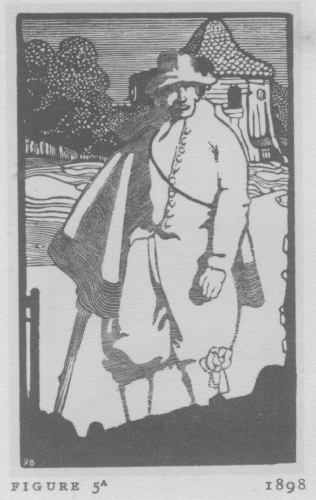 A word now to save you slipping on the wood, and
otherwise marking the wood by accident. Look at fig. 5A, which I call
'D'Artagnan's Man,' and imagine yourself cutting away that piece of
white between his stick and his breeches. You will run the tool down
the side of the stick and down the side of the breeches. But you must
be careful how you remove all that waste ground between those two
lines, and your best thing is generally to cut towards the line or
'ditch' that you've made, so that your gouge at each thrust is
stopped by the ditch.
A word now to save you slipping on the wood, and
otherwise marking the wood by accident. Look at fig. 5A, which I call
'D'Artagnan's Man,' and imagine yourself cutting away that piece of
white between his stick and his breeches. You will run the tool down
the side of the stick and down the side of the breeches. But you must
be careful how you remove all that waste ground between those two
lines, and your best thing is generally to cut towards the line or
'ditch' that you've made, so that your gouge at each thrust is
stopped by the ditch.
I give you here a little block (fig. D) showing you something like that portion in the 'D'Artagnan's Man' block.
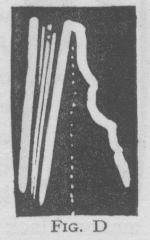
You will see the two white lines cut down on each side of the stick, and you will see the crinkly line down the side of the breeches. Now look at the little line of dots which runs down the middle. When you want to clear away all this black middle part, the point of the tool must be on one of those dots and you must cut towards one of the ditches. We will now cut towards the ditch by the side of the stick (see fig. E).
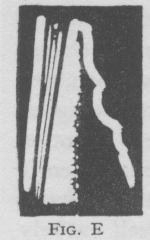
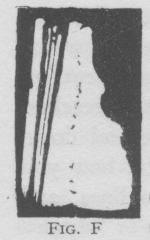
Now we will cut towards the ditch by the side of the breeches (see fig. F). That leaves a certain number of black dots in the middle (fig. F). These you remove by going from north to south (Fig. G).
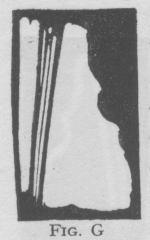
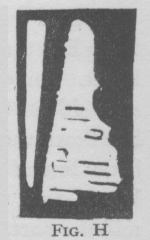
The purpose of all this is to avoid indenting the edge of the stick or the breeches. Fig. H shows the indentation. Those distinct marks which you see down the side of the edge of the stick and the indistinct ones on the edge of the breeches are caused by the back of the tool pressing on the wood. That is not good unless you expressly want such marks to show; and then this will explain to you how to do it without any effort.
You will see in many of the wood-engravings of the nineteenth century a number of the lines cross-hatched. I was never able to achieve proper cross-hatching because I never saw any use for it, though I played with it once. It seems to me to be only really useful in etching; it was after having found it useful there, I suppose, that the studios passed it on to one another, and the wood- engravers brought it into their own craft. If I were you, I shouldn't bother about cross-hatching. You know, of course, that cross-hatching means black lines crossing one another. The old text-books devote many pages to this same cross-hatching. Let us hope that some day one wood-engraver will use it brilliantly, and then all our dislike for it will have to vanish.
The question as to how much black you should allow in a wood-block, how much white, and how much grey, is one that I cannot answer. The black as used by Vallotton or Nicholson or Crawhall is gay enough for me - perfectly glorious! but it would have depressed Mr. Ruskin beyond all words.
You will find what Mr. Ruskin wrote about this use of black at the beginning of this book, and you will find, on the same page, what Odilon Redon wrote. I take it Ruskin had been looking at some of the engravings by the men of 1860 and 1870 when he got so cross about the black, because it is all nonsense to say that the 'eye is greatly saddened and offended by quantity of black,' in the work of the masters, old or new - and the old masters were very fond of it.
And yet there is something mighty true about old Ruskin's 'nonsense.' I think so because when I was in Moscow in 1909 I went to see a play by Andreieff called Life of a Man. It began in black, and it ended in black, but I didn't stay till the end. I went out in the middle of the second act, feeling ill.
The scene was composed of some big black velvet curtains, and on these had been either sewn or drawn certain white lines, representing the perspective lines of the ceiling, floor, and the four walls. Against these were placed tables and chairs which had been painted white, and the people were dressed so as to look like outline drawings. I asked one of the stage managers why this was done. He told me it was done so as to achieve something Aubrey Beardsley had achieved in his black and white drawing when he used a white line on a black background.
I am glad I am alive and able to tell you all this, but I am certain that Mr. Ruskin would have died. For to have a space of about thirty-six square feet of blackness in front of you, with those awful white lines to emphasise the blackness, and to emphasise the stupidity of an attempt to represent an enlarged black and white drawing on the stage, is to kill you in the ordinary way if you're a serious person; and to make you die of laughter if you refuse to take it seriously. But I think a black and white drawing is a very different thing, and I cannot feel that the black is offensive, but am entirely of Odilon Redon's opinion.
If I have an ideal in wood-engraving it is to make my black lines and my white spaces so equal in their strength that a strong grey is achieved. And I would like my black line to be about as thick as the capital letter I used on this page. It is for this reason that, if the artist be allowed to have a special fancy for any of his blocks, mine is for that little block which represents a pyramid.
If you ask the advice of some wood-cutter to start you going, as I hope you will, he will probably tell you not to tip the point of your tool too deep in the block, and not to tip it too high, that in your progress you suddenly slip.
How to hold the tool; how to hold the block; how not to dip or rise; these are things you can learn in half an hour if you will pay attention and if you have a friend who will show you for the first ten minutes, and watch you blundering for twenty, and help you twenty times.
And it is because this is all you have to learn, that I say it is not difficult to wood-engrave. Then you practise for two or four or ten years, and perhaps you may engrave some blocks that are delightful.
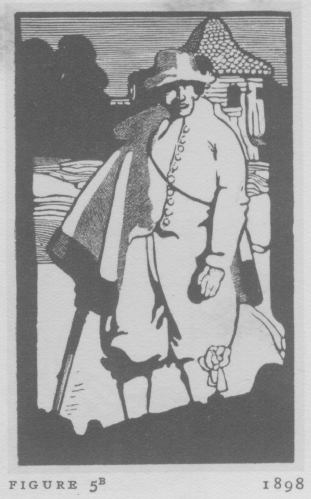 And now
about the printing. Since you don't need to bother yourself about
this at first, the best thing to do when you decide to begin
wood-cutting is to discover a little printer nearby who has a small
hand press. You'd better take him the paper, and let it be fairly
smooth; not greasy and not too thick. Get him to damp it slightly and
then ask him to make one light imprint and one very heavy imprint.
The heavy one will show you what has yet to be cut away.
And now
about the printing. Since you don't need to bother yourself about
this at first, the best thing to do when you decide to begin
wood-cutting is to discover a little printer nearby who has a small
hand press. You'd better take him the paper, and let it be fairly
smooth; not greasy and not too thick. Get him to damp it slightly and
then ask him to make one light imprint and one very heavy imprint.
The heavy one will show you what has yet to be cut away.
You will see on figs. 5B and 5C, 'D'Artagnan's
Man,' some black marks between the stick and the breeches which had
no business to be there. That means that I did not cut that white
space deep enough. Figs. 5B and 5C are proofs of the block before it
was finished. In fig. 5A, a later print of the same block, you will
see they have gone.
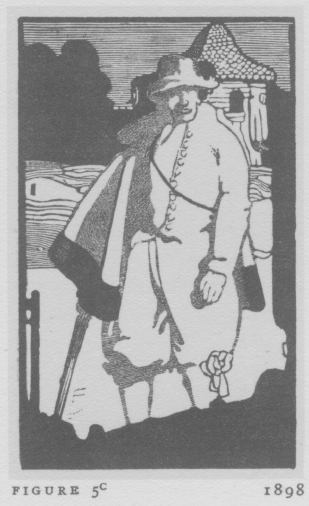 I think
you should be very careful to tell the printer to use black ink, or
brown ink if you prefer it, although it is difficult to get a good
brown. Sometimes printers come out with a choice Prussian blue which
is enough to knock the heart out of anybody except Mr. Ruskin.
I think
you should be very careful to tell the printer to use black ink, or
brown ink if you prefer it, although it is difficult to get a good
brown. Sometimes printers come out with a choice Prussian blue which
is enough to knock the heart out of anybody except Mr. Ruskin.
One of the best early designs for you to practise on are initial letters; because you can draw your letters and put in behind them a few trees, a castle or a pattern, as a background, or little figures, or anything you like without feeling that you have to make a masterpiece right away. I believe that it is rather easier to begin with a letter composed of right angles than a curved one. An 0 is very difficult, an S by no means easy; but a T, an I, an N or an H will not discourage you. You can leave your letters black, or you can do as I have done in some of the initial letters here, you can pick the black out. But leave it black to begin with and pick it out after your first proof. But don't be in a hurry to cut away anything, and I don't think you can tell yourself this too often. Leave more folds in a dress, more marks in a face, more bars in a fence, more curls in smoke, than you finally come to need, because there is no great hurry, and you can always cut out later on, whereas you cannot put them back - at least not easily.


